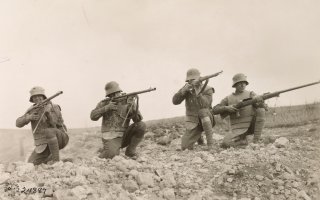These Weapons Made World War I Hell on Earth
A lack of understanding of the potential killing power of machine guns escalated the carnage.
While the American Expeditionary Force had to rely on the Chauchat, and to a lesser extent the Lewis Gun, John Browning was already working on something truly innovative. The Browning Automatic Rifle, which only reached American soldiers in the closing months of the war, was designed to be carried by advancing infantrymen. It could be fired from the hip and introduced the concept of “walking fire,” which was thought to be necessary given the static trench lines.
The weapon could also be used as a light machinegun and fired from a bipod, which was introduced in the later models. The BAR, which was saw action in World War II, Korea and even some early service in Vietnam, was also notably used by bank robbers Clyde Barrow and Bonnie Parker! This is especially noteworthy as Ms. Parker was reported to weigh just ninety-pounds and she was able to carry and fire the nearly sixteen-pound automatic rifle.
Automatic Pistols
The BAR, Chauchat and Lewis Gun provided some mobility to the infantryman, but by the end of the First World War the machinegun had truly been reduced in size. With this innovation came the birth of the submachine gun, which were small automatic weapons designed to fire pistol-sized cartridges.
In fact, the Germans created the concept as a “machine pistol,” or “maschinenpisole.” Hugo Schmeisser, who has erroneously been forever tied to the MP-38/40 but did in fact create the StG44, should also be remembered as the father of the sub-machinegun. While working for the Bergmann Waffenfabrik firm Schmeisser, along with Theodor Bergmann, developed a new type of weapon. It was the Maschinenpistole 18/I, more commonly known as the MP-18.
This submachine gun was used by the Germans during the final stages of the war, and it was so successful in its design that it directly influenced later submachine guns. What made the MP-18 as it is now known unique is that it featured an open bolt blowback action and fired pistol rounds.
It was originally designed to use the snail drum of the Luger Artillery model pistol, and this provided the soldier with thirty-two rounds of 9mm Parabellum. The downside to this however was that the shooter was required to have a special tool to reload the magazine.
After the war the MP-18 was modified to use a straight magazine, which was later used in the MP-38/40 submachine gun. With Germany forbidden to manufacture the MP-18 after the war, production continued in secret and the weapon was improved in 1928, adding a selector for single shot as well as automatic fire. The MP-28 was subsequently used in World War II and even copied by the British as the Lanchester submachine gun.
While the MP-18 was the first true purpose designed submachine gun the Italians actually developed the Villar-Persoa as a dual barrel light machinegun for use with aircraft. It also fired pistol rounds rather than rifle rounds to increase the rate of fire and to provide more rounds for the second crew member/observer in the military aircraft. The weapon’s 9mm rounds proved insufficient to shoot down aircraft and the gun was then issued to ground troops in a single barrel configuration.
The French Army also experimented with lighter machineguns and attempted to remedy some of the flaws of the Chauchat with a “pistolet-mitrailleur”—or submachine gun—that was originally intended to provide protection for French tank crews. However, the weapon never entered mass production and today it is largely a forgotten weapon from a conflict that saw many interesting attempts at small arms design.
By contrast the Americans scored a series of hits—notably with the aforementioned BAR, which arrived at the tail end of the war, but also with the gun that was a little too late. It was of course the Thompson submachine gun.
While its namesake was General John T. Thompson, who had envisioned a semi-automatic rifle to replace the bolt action rifles in use during the war, it was Theodore H. Eickhoff, Oscar V. Payne, and George E. Goll who were the “Tommy Guns” principal designers.
Together they created what Thompson originally saw as a “one-man, hand-held machine gun,” and designed a weapon that fired the .45 ACP round. Known as the “Trench Broom” or the “Annihilator” the weapon was officially renamed the “Thompson Submachine Gun,” the first small arm to actually earn the moniker of “submachine gun.”
The Tommy Gun of course never saw service in the trenches. It was in fact too late, and only entered production in 1921. However, as with the BAR it would prove to have a colorful history in the interwar period, and even pave the way for the weapons of the next World War.
Peter Suciu is a Michigan-based writer who has contributed to more than four dozen magazines, newspapers and websites. He regularly writes about military small arms, and is the author of several books on military headgear including A Gallery of Military Headdress, which is available on Amazon.com.
This article first appeared in January 2021.
Image: Wikimedia Commons

